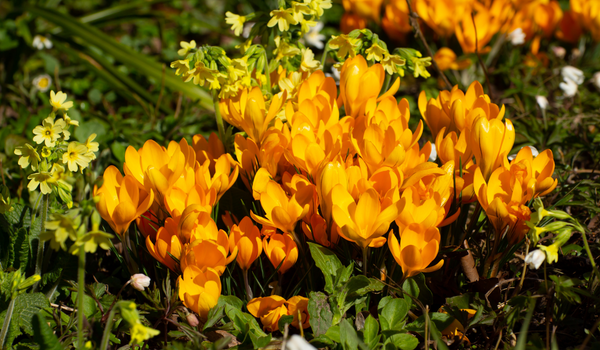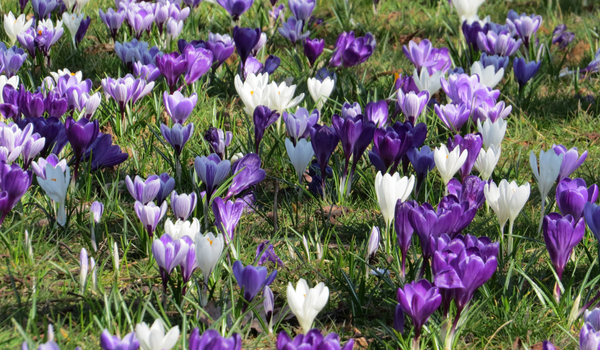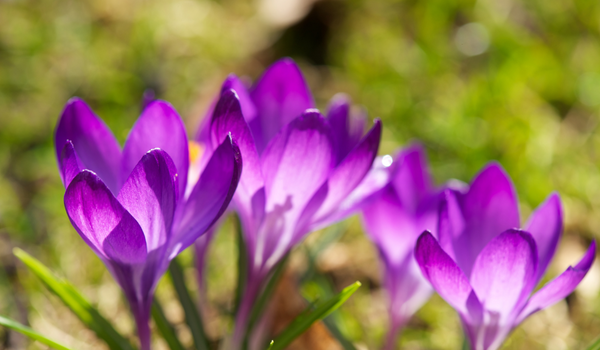The ultimate guide to planting, growing, and caring for your Crocus!
Welcome to the definitive guide on cultivating the vibrant beauty of Crocuses! These charming flowers paint gardens with hues ranging from deep purples to sunny yellows, captivating gardeners worldwide. In this comprehensive guide, we'll dive into everything you need to know about planting, nurturing, and preserving the splendor of Crocuses. From understanding optimal planting conditions and soil preparation techniques to expert care tips, we're here to empower you with the knowledge to foster these delicate blooms. Whether you're a seasoned gardener or just starting your floral journey, let's embark together on this enchanting exploration of Crocus cultivation!
Planting your Crocus: step-by-step
Planting Crocuses is a delightful way to bring early spring color to your garden. Start by selecting a well-draining spot with ample sunlight. Loosen the soil and mix in organic matter to enhance drainage and fertility. Dig holes about 3 inches deep, placing the bulbs with the pointed ends facing upwards. Space them about 3 to 4 inches apart to allow for natural spreading. Cover with soil, lightly press down, and water thoroughly. During fall planting, consider protecting the bulbs from squirrels by placing wire mesh over the planting area. Crocuses thrive in USDA zones 3-8 and require minimal maintenance once established, offering charming blooms year after year.

Optimal timing for Crocus bulb planting
The ideal time to plant Crocus bulbs is during the fall season, typically from late September to early November, before the ground freezes. Planting during this period allows the bulbs to establish strong root systems before winter sets in, leading to vibrant blooms in early spring. Select a location with well-draining soil and ample sunlight. Aim for a planting depth of around 3 to 4 inches (7.5 to 10 cm), spacing the bulbs approximately 3 to 4 inches apart. This timing ensures that the bulbs have sufficient time to acclimate to the soil conditions and temperature fluctuations, fostering healthy growth and beautiful blossoms come springtime.
Enhancing growth: soaking Crocus bulbs
To optimize the growth of Crocus bulbs, consider soaking them before planting. It is not necessary, but it can help the bulbs to grow faster. Soaking Crocus bulbs for a few hours (approximately 2-3 hours) in lukewarm water encourages quicker root development and kickstarts their growth process. This method helps to hydrate the bulbs, promoting faster establishment and potentially earlier flowering. However, avoid excessively long soaking periods as it might lead to rot. Once soaked, plant the bulbs in well-draining soil with good sunlight exposure.
Prime locations for planting Crocuses
For optimal growth and vibrant blooms, choosing the right location is key when planting Crocuses. These resilient bulbs thrive in well-draining soil and prefer areas with full or partial sunlight. Ideal spots include garden borders, rock gardens, and under deciduous trees where they can receive sunlight before the tree's canopy fully forms. Ensure the soil is fertile, loamy, and not prone to waterlogging. Crocuses also excel in containers, brightening patios and balconies. Plant them at a depth of around 3-4 inches, spaced apart for an impressive display.

Pots vs. ground
When choosing between pots and the ground for planting crocus bulbs, both options offer unique advantages. Pots provide better control over soil conditions, making them ideal for those with limited outdoor space or for creating stunning indoor displays. They allow easy movement to optimize sunlight exposure and protection from harsh weather. On the other hand, planting crocus bulbs directly in the ground offers natural insulation, enabling the bulbs to establish a more robust root system. This method also allows for a more extensive spread and naturalization over time. Ultimately, the choice between pots and the ground for crocus planting depends on available space, desired display location, and the level of control desired over growing conditions.
Cultivating Crocus flowers: best practices
To cultivate vibrant Crocus flowers, start by selecting a well-draining soil with good fertility. Plant the bulbs in autumn, around 3-4 inches deep and 2-3 inches apart, in a spot receiving ample sunlight. Ensure the soil is loose and enriched with organic matter, promoting proper drainage and healthy root growth. Crocuses prefer slightly acidic to neutral soil pH. After planting, water them moderately but consistently, especially during dry spells. Mulching helps retain moisture and insulate the bulbs during winter.
Understanding Crocus growth timing
Understanding Crocus growth timing is essential for successful cultivation. Crocuses, often among the earliest bloomers in spring, display diverse growth patterns. These resilient bulbs thrive in well-drained soil with sufficient sunlight. Generally, Crocus species exhibit distinct growth phases, starting with early, mid, or late-season bloomers. Fall-planted varieties typically root in autumn, remain dormant during winter, and emerge in early spring, delighting with vibrant blossoms. Conversely, spring-planted Crocuses may bloom later in the season. Recognizing their growth cycles aids in strategic planting, ensuring a prolonged and colorful display of these enchanting flowers throughout the spring months in your garden.

Crocus blooming secrets
Crocuses, heralds of spring, thrive when planted in well-drained soil receiving ample sunlight. The secret to vibrant crocus blooms lies in planting them at the right depth—around 3 to 4 inches deep and 2 to 3 inches apart. Ensure the soil is loose and fertile, enriched with organic matter for optimal growth. Adequate moisture during their growth period, followed by a dry dormant phase, encourages robust flowering. These resilient bulbs favor slightly acidic to neutral pH levels. Additionally, a layer of mulch aids in moisture retention and insulation.
The art of deadheading
Deadheading, the practice of removing spent flowers from plants, is a crucial technique to encourage prolonged blooming and maintain the overall health of your flowers. By snipping off faded or wilted blooms, you redirect the plant's energy toward new growth and additional blossoms. For flower bulbs like tulips or daffodils, deadheading prevents the plant from channeling resources into seed production, promoting stronger bulb development for the following season. Use sharp, clean pruners and trim just above the first set of healthy leaves or nodes. Regular deadheading throughout the blooming season helps to extend the colorful display of your garden and supports the bulb's vitality.
Blooming duration: life span of Crocuses
Crocuses typically exhibit a blooming duration of about 1 to 3 weeks. These charming flowers grace gardens and landscapes with their vibrant hues early in the season, delighting with a burst of color. Factors like weather conditions, species variation, and local climates can influence their longevity. Generally, once Crocuses bloom, their flowers endure for a few days to a week before gradually fading. However, their foliage persists longer, absorbing energy for the bulb's growth and ensuring a robust return next spring. Understanding their brief but captivating bloom cycle helps plan and appreciate these lovely flowers in the garden.

Crocus expansion: do they multiply?
Crocuses are known for their ability to multiply and naturalize over time. These resilient bulbs reproduce by forming offsets, which are smaller bulb-like structures that develop alongside the main bulb. As the plant matures, these offsets grow into new crocus plants, contributing to their expansion. Adequate growing conditions, including well-draining soil and ample sunlight, encourage robust multiplication. Once established, crocuses will often spread gradually, forming colorful clusters and enhancing the garden landscape. Regular division of clumps every few years can also help manage overcrowding, ensuring continuous bloom and healthy growth.
How many Crocuses can you grow from one bulb?
A single Crocus bulb typically yields one flowering plant, showcasing its vibrant blooms. When properly cared for and given optimal growing conditions, such as well-drained soil and adequate sunlight, a Crocus bulb can potentially develop offsets or smaller bulbils over time. These offsets can be separated from the parent bulb and cultivated to produce additional Crocus plants, allowing for the propagation and expansion of your Crocus garden. Although the exact number of Crocuses from one bulb varies, nurturing the bulbs and providing favorable conditions enhances their potential for multiplication.
Nurturing your Crocus: care essentials
To nurture your Crocus effectively, begin with well-draining soil to prevent waterlogging and ensure a sunny to partially shaded location. Before planting, loosen the soil to a depth of about 4-6 inches and mix in organic matter like compost for improved fertility. Crocuses thrive in slightly acidic to neutral soil pH levels. Ensure the bulbs are planted 3-4 inches deep and about 2-3 inches apart in the fall for spring blooms. Adequate watering after planting and during dry periods is crucial, but avoid excessive moisture as it may cause bulb rot. Apply a balanced fertilizer in early spring to support healthy growth. Regularly remove spent flowers to encourage new growth and bulb multiplication.

Year-round ground habitation
Crocuses, typically, thrive when planted in the fall for a dazzling spring bloom. However, leaving Crocus bulbs in the ground year-round is possible and often recommended. These hardy bulbs acclimate well to the soil, enduring both cold winters and warm summers, especially in climates with well-draining soil. While some gardeners may prefer lifting and storing bulbs after flowering, Crocuses are resilient and can survive if left undisturbed. To ensure their perennial beauty, it's essential to plant them in a location with adequate drainage to prevent waterlogging, allowing them to naturalize and multiply over time for a stunning display each spring.
Trimming tactics: Crocus pruning guide
Trimming Crocuses is a straightforward process that can enhance their growth and appearance. Once the flowers have wilted and the foliage begins to turn yellow, it's time for pruning. Using clean, sharp shears, carefully trim the yellowing foliage, ensuring you leave about an inch above the soil. This allows the plant to absorb nutrients for next year's bloom. Avoid cutting the leaves too early, as they provide nourishment to the bulb. After pruning, consider adding a layer of mulch to insulate the soil and protect the bulbs during the dormant season. Proper trimming promotes healthier Crocuses, encouraging a vibrant display in the following season.
Ideal Crocus fertilizers
The optimal fertilizers for Crocuses are typically low-nitrogen, high-potassium blends or specialized bulb fertilizers. A phosphorus-rich fertilizer (such as a 5-10-10 NPK ratio) is excellent for promoting robust bulb development and vibrant blooms. Organic options like bone meal or compost can also provide the necessary nutrients. When applying fertilizer, it's crucial to do so sparingly in the fall during planting and again in early spring as the shoots emerge. Remember to follow package instructions, avoiding excessive fertilization to prevent damage to these resilient yet delicate flowers.
Share
